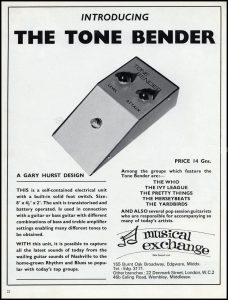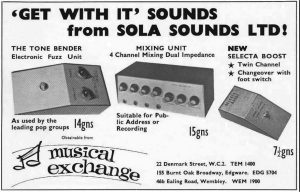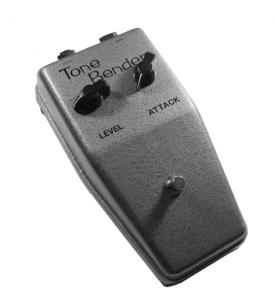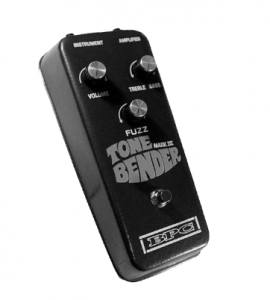 The UK fuzz box phenomenon began in 1965 when electronics engineer Gary Stewart Hurst was approached by James Bond theme guitarist Vic Flick to modify his existing Maestro FZ-1 Fuzz-Tone pedal in order to give the unit more sustain. Gary Hurst’s modifications of the FZ-1 led him to design his own circuit, the ‘Tone Bender’. Originally housed in wooden boxes made by Gary’s brother. these units were distributed to artists across London, including Yardbirds guitarist Jeff Beck, and Featured a circuit that consisted of one OC75 and two 2G381 transistors. Original examples of the wooden case models are very rare to find with only a small handful of examples being produced. As well as top and rear jack sockets The Wooden Case models feature level and bias control which enables the user to tune in their perfect fuzz tone.
The UK fuzz box phenomenon began in 1965 when electronics engineer Gary Stewart Hurst was approached by James Bond theme guitarist Vic Flick to modify his existing Maestro FZ-1 Fuzz-Tone pedal in order to give the unit more sustain. Gary Hurst’s modifications of the FZ-1 led him to design his own circuit, the ‘Tone Bender’. Originally housed in wooden boxes made by Gary’s brother. these units were distributed to artists across London, including Yardbirds guitarist Jeff Beck, and Featured a circuit that consisted of one OC75 and two 2G381 transistors. Original examples of the wooden case models are very rare to find with only a small handful of examples being produced. As well as top and rear jack sockets The Wooden Case models feature level and bias control which enables the user to tune in their perfect fuzz tone.
Tone Bender Launches
 During 1965 Gary re-housed the Tone Bender circuit into a metal casing, making the pedal much more durable for stage use. The early models featured hand-applied lettering that was simply covered with nail varnish to protect its fragility. This along with a flat gold finish gave it a distinct look. This version is commonly known as the MK1 Tone Bender. To launch his new product, Gary approached London retailer Sola Sound, to market and distribute the pedal from their London store, Musical Exchange. The MK1 has a very distinctive sound and found its way into the hands of many famous guitarists such as Jeff Beck, Mick Ronson, and Pete Townshend. The MK1 can be heard on many classic tracks including Beck’s Bolero & Moonage Daydream from David Bowie’s Ziggy Stardust album. The Tone Bender had become part of British music history.
During 1965 Gary re-housed the Tone Bender circuit into a metal casing, making the pedal much more durable for stage use. The early models featured hand-applied lettering that was simply covered with nail varnish to protect its fragility. This along with a flat gold finish gave it a distinct look. This version is commonly known as the MK1 Tone Bender. To launch his new product, Gary approached London retailer Sola Sound, to market and distribute the pedal from their London store, Musical Exchange. The MK1 has a very distinctive sound and found its way into the hands of many famous guitarists such as Jeff Beck, Mick Ronson, and Pete Townshend. The MK1 can be heard on many classic tracks including Beck’s Bolero & Moonage Daydream from David Bowie’s Ziggy Stardust album. The Tone Bender had become part of British music history.
Transitional Changes
 During 1966 the Tone Bender went through many changes. Gone was the original folded metal casing and a new space-age aluminium cast casing came to the forefront as the new housing. Around 1966 several other fuzz boxes appeared on the market including the Dallas Arbiter Fuzz Face.
During 1966 the Tone Bender went through many changes. Gone was the original folded metal casing and a new space-age aluminium cast casing came to the forefront as the new housing. Around 1966 several other fuzz boxes appeared on the market including the Dallas Arbiter Fuzz Face.
These new effects featured a two-transistor circuit. The Tone Bender matched their performance, moving to a two OC75 circuit, giving more grit and bite to the tone. These models were only produced for a short period and are affectionately known to many, based on the transitional circuit as the MK1.5 Tone Bender. This was the pedal used by The Beatles in Abbey Road Studio while recording Rubber Soul.
 Tone Bender Developments
Tone Bender Developments
1967 saw Vox move their Tone Bender production to the Italian Jen factory, resulting in the release of the V828 Tone Bender. Sola Sound continued to develop the Tone Bender circuit and in 1968 launched their new three control Tone Bender featuring a new punched metal casing, circuit board and three OC75 transistors. The MK3 Tone Bender was supplied as a pedal to various manufacturers including Park, Rotosound and Vox. Led Zeppelin guitarist Jimmy Page was again eager to try the new version of the Tone Bender and can be seen in 1969 using the Rotosound version of the three-knob tone bender. The 1970s saw the MK3 Tone Bender change from the traditional Germanium transistors to more Consistent silicon units.
Click here for our Tone Bender pedals
Famous Tone Bender Users
Jimmy Page
Jeff Beck